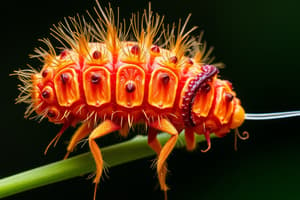Podcast
Questions and Answers
Which of the following is a living thing?
Which of the following is a living thing?
- A human (correct)
- A chair
- A table
- A rock
What is a defining characteristic unique to living things?
What is a defining characteristic unique to living things?
- They need food, water, and shelter
- They exist in nature
- They are created by God
- They can move on their own (correct)
Which of these items does NOT need food, water, or shelter to survive?
Which of these items does NOT need food, water, or shelter to survive?
- A fan (correct)
- A plant
- A bird
- An animal
What can be inferred about non-living things from the text?
What can be inferred about non-living things from the text?
Which pair is correctly matched as living and non-living things?
Which pair is correctly matched as living and non-living things?
What does the child do immediately after taking a bath?
What does the child do immediately after taking a bath?
Which part of the body is specifically mentioned as being shiny?
Which part of the body is specifically mentioned as being shiny?
What action does the child think a dog would use to dry off?
What action does the child think a dog would use to dry off?
Which of these body parts does the child not mention wiping?
Which of these body parts does the child not mention wiping?
What is the primary theme of the poem 'Wipe Till Dry'?
What is the primary theme of the poem 'Wipe Till Dry'?
Flashcards are hidden until you start studying
Study Notes
Living and Non-Living Things
Introduction
- The chapter discusses the difference between living and non-living things.
Living Things
- Examples of living things: humans, animals, and plants.
Non-Living Things
- Examples of non-living things: rocks, tables, chairs, and fans.
Special Features of Living Things
Movement
- Living things can move from one place to another on their own.
- Examples: birds can fly and humans can walk.
Poem Summary
- The poem "Wipe Till Dry" is about a child's routine after taking a bath.
- The child describes the process of drying themselves after a bath.
Actions After Bath
- The child wipes their hands, fingers, toes, legs, and nose to dry themselves.
Imaginative Comparison
- The child wishes they could shake their body like a dog to dry faster.
Poem Details
- The poem "Wipe Till Dry" is written by Aileen Fisher.
- The poem is accompanied by an image of a happy boy after a bath, standing next to a filled basin with a towel around his waist and his hands out.
Studying That Suits You
Use AI to generate personalized quizzes and flashcards to suit your learning preferences.




